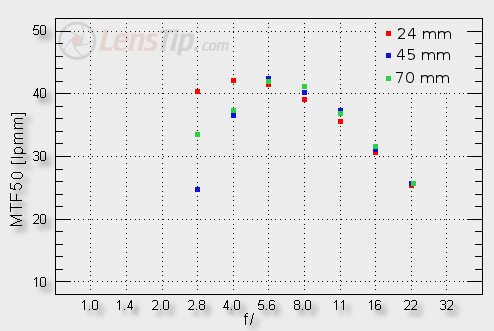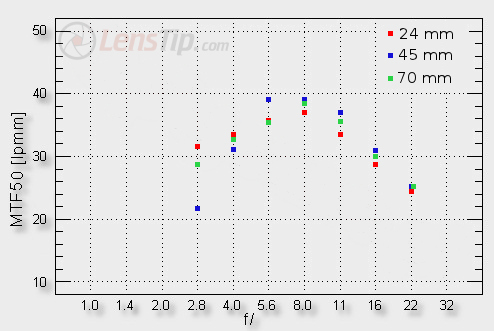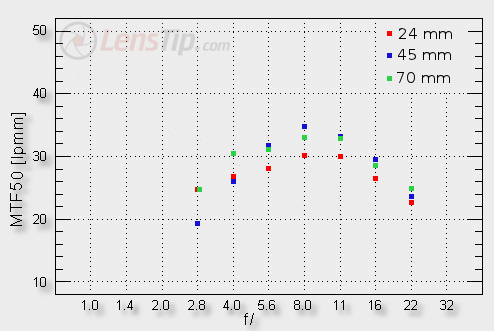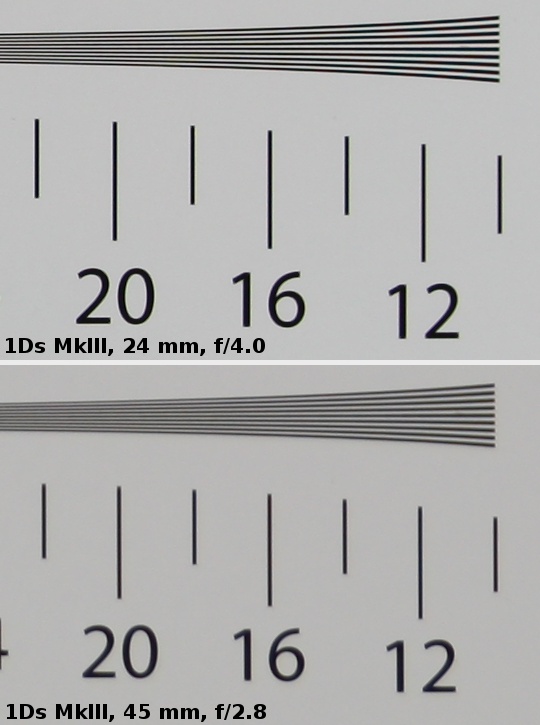Tamron SP 24-70 mm f/2.8 Di VC USD
4. Image resolution
Although we haven’t tested the new Canon 24-70 mm f/2.8 yet, we still have a test of its predecessor, performed on the Canon EOS 20D, in our database. As that camera has the same pixel density as the 1Ds MkIII its results will be perfect for direct comparisons as well.
Now let’s check how the Tamron SP 24-70 mm f/2.8 Di VC USD fares in this category- first its results from the frame centre at 24, 45 and 70 mm.
Please Support UsIf you enjoy our reviews and articles, and you want us to continue our work please, support our website by donating through PayPal. The funds are going to be used for paying our editorial team, renting servers, and equipping our testing studio; only that way we will be able to continue providing you interesting content for free. |
- - - - - - - - - - - - - - - - - - - - - - - - - - - - - - - - - - - - - - - - - - - - - - - -

The lens should be only praised when it comes to its results at the shortest focal length. Even at the maximum relative aperture we get there a very high value of about 40 lpmm and on slight stopping down we reach the level of 42 lpmm.
However the crisis the lens undergoes in the middle of the focal range is a huge surprise. It is felt the most keenly at the maximum relative aperture where the result you get doesn’t even allow to call the image useful. Fortunately on stopping down you see a significant improvement of the image quality and by f/4.0 you get already a quite good value of over 36 lpmm.
Good results (but not as excellent as those on the shortest focal length) appear again at the maximum focal length again. The values of almost 34 lpmm, reached at the maximum relative aperture, are hard to criticize and on stopping down you see them even improved.
Unfortunately the performance of the Tamron compares unfavourably with that of its competitors. The Nikkor 24-70 mm was also the best at the shortest focal length but it fared at longer focal lengths as well and there were no significant crises visible. The Sigma 24-70 mm f/2.8 EX DG HSM was a bit worse than the Nikkor, especially at the maximum relative aperture, but even there it doesn’t descend below 34 lpmm. The Tamron can compete the most efficiently with the old Canon 24-70 mm which, being a tad worse at the focal range ends, still wins in the middle where the Tamron is at its weakest.
Now let’s check the situation on the edge of the APS-C sensor.

All the combinations of apertures and focal lengths deserve positive or even very high notes here, apart from 45 mm focal length and f/2.8 aperture where the result is weak, on a level of 22 lpmm. It should be emphasized that these values are still noticeably better than those of the old Canon 24-70 mm. The Tamron also doesn’t have to be inhibited when compared to the Nikkor 24-70 mm. The latter is better only in the middle of the focal lengths’ range. The Tamron remains noticeably better at both ends as it doesn’t have any problems with reaching useful images even at the maximum relative aperture. The comparison to the Sigma is a bit more tricky. The Tamron presents itself better at the maximum relative aperture because the Sigma is never fully useful on the edge of the APS-C sensor. The Tamron’s results improve more slowly on stopping down – the Sigma is very quick. What’s more the Sigma fares the best exactly where the Tamron is the worst – in the focal range centre.
We still have to discuss the performance on the edge of the full frame sensor. An appropriate graph is presented below.

Here some reservations can be expressed only by f/2.8 and f/4.0. If you want to be sure you’ll get really sharp images you shouldn’t use these apertures at all, closing the lens down to near f/5.6. The rival Sigma fared very much alike although in its case the graph was a lot steeper. The achievements by f/2.8 were worse than those of the Tamron, then the lens fared a bit better by f/4.0 and by f/5.6 and f/8.0 – significantly better.
At the end of this chapter we would like to present some crops taken from our test photos, saved as JPEG files alongside the RAW files, used for the analysis above.
 |






